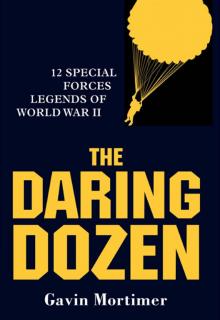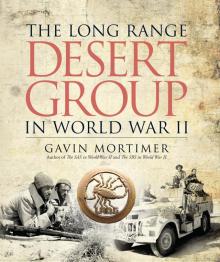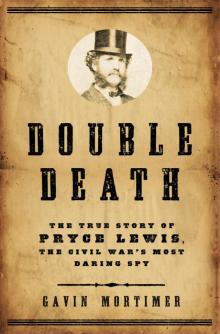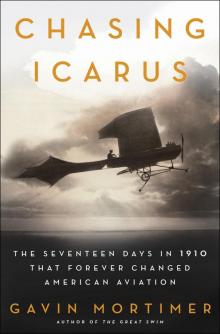- Home
- Gavin Mortimer
Double Death Page 4
Double Death Read online
Page 4
*There is confusion as to the exact year the agency was founded. On one occasion Allan Pinkerton gave 1850 as the date and on another 1852. The agency probably began on a small scale in 1850 but took off two years later, the year Pinkerton appeared to part company with Rucker and go it alone.
C H A P T E R F O U R
“A Plan Had Been Laid for My Assassination”
THE YEAR THAT PRYCE LEWIS had arrived in New York, 1856, coincided with the election of Democrat James Buchanan as the fifteenth president of the United States. As Lewis traveled the eastern states selling books, he would have read in the newspapers of the demands of the Buchanan administration to extend the slave area. Since the Missouri Compromise of 1820 the states north of the Mason-Dixon Line (the boundary between Pennsylvania and Maryland) had been “free states,” but by the early 1850s the Southern states wanted to expand slavery into these free states. In particular they had their eye on Kansas and Nebraska, two states west of the Mason-Dixon Line, and throughout the 1850s the states were at the center of a tug-of-war between the antislavery states and the Southern states. The citizens of Kansas in particular were opposed to slavery, but their attempts to be recognized as a free state were continually blocked by Buchanan and the Democrats, although the issue proved to be the rock on which the Democratic Party was smashed during the stormy run-up to the 1860 election.
The Northern Democrats knew that if they acceded to demands from their Southern brothers to extend slavery into Kansas and Nebraska they would be voted out of office, so they (with the support of some Southern Democrats) nominated Illinois’s Stephen Douglas as their presidential candidate, a man who believed that it was for the people of a state to decide for themselves whether they should be free or slave; the enraged Southern Democrats held their own convention and elected the pro-slavery John Breckinridge of Kentucky as their nominee. By doing so the two bitter factions knew they had all but handed the presidency to the Republicans—the “Black Republicans” as they called their hated adversaries—but such was the divisive nature of the slavery issue that the Democrats were unable to work together to save their party.
The Republicans, however, whose ultimate aim was to abolish slavery, still had to choose a candidate who would appeal to voters in all the free states, from New Jersey to Illinois to California. The belligerent William Seward had been an early front-runner but was seen as too much of a radical; the fiery manner in which he denounced slavery alarmed senior Republicans, who knew that many voters in the North were indifferent to slavery. There was also a whiff of scandal around Seward, corruption emanating from his political manager, Thurlow Weed.
But who else was there? Simon Cameron and Salmon Chase were talented, but both had as many weaknesses as strengths. Which left only Abraham Lincoln, the Illinois “rail-splitter” who had been born in a log cabin fifty-one years earlier. He was opposed to slavery, but less forcefully than either Seward or Chase, and he was popular among immigrants, who saw him as the personification of the American dream: a man from the backwoods who had risen to become a lawyer and a politician. Perhaps, most significant of all, Lincoln’s integrity was indubitable. He was known as “Honest Abe,” and his reputation was untainted by scandal.
Lincoln won the Republican nomination and in November 1860 claimed the presidency, carrying every free state bar New Jersey. But he won only 40 percent of the popular vote (54 percent in the North), and in the Southern states news of his election was greeted with despair. A young English governess named Sarah Jones was staying at the Exchange and Ballard Hotel in Richmond, Virginia, on election day and witnessed the effect of the result on the population.
From early morning voting was going on at several public buildings in the neighborhood … at every corner men were comparing notes and hourly bulletins were issued respecting the various polls throughout the country … long and continued shouts and huzzahs assailed one’s ears from time to time till towards midday. Success seemed to gleam around. By and by the shouts became less frequent. News from more distant regions must have changed the aspect of affairs and chilled their hopes. Next one perceived a depression in the looks of passers-by, more so and so, then the groups dispersed in silence. By dusk a funeral cloud seemed to hang over the city. By nine o’clock the town seemed hushed in sleep. The night before the hotel had been noisy with tramping and merriment, serenaders outside and hopeful politicians within had prolonged the revels to a late hour. Now the disappointment seemed too great for utterance.
It took a while for the result to sink in, and for the Southern states to formulate a response. The first to do so was South Carolina, which called a convention to vote on whether to secede from the Union and form an independent republic. The result of the vote was announced on December 20, 1860: 169–0 to secede. The correspondent of the London Times was shocked at the depth of feeling he witnessed at the convention, commenting that “there is nothing in all the dark caves of human passion so cruel and deadly as the hatred the South Carolinians profess for the Yankees.” The surprise of the Times’ reporter at the depth of American feeling was indicative of his country’s unpreparedness for the impending conflict. Immediately after the election of Lincoln, Lord Lyons, the British minister in Washington, sent a dispatch to Lord John Russell, the foreign secretary, in which he predicted that the fallout from the election result was a storm that would soon blow over. In Russell’s reply to Lyons, dated January 10, 1861, he expressed the opinion that “the best thing now would be that the right to secede should be acknowledged … I hope sensible men will take this view.” Lyons had assured Russell that Lincoln was “no Radical,” so it seemed likely to the British that the president-elect would grant the Southern states their wish in order to avoid conflict. That was certainly the view taken by the Economist journal in its January edition when it wondered why the North hadn’t already taken the opportunity to “shake off such an incubus and to purify [itself] of such a stain.”
But in January 1861 more states followed South Carolina’s example, and by early February Mississippi, Florida, Alabama, Georgia, Louisiana and Texas no longer belonged to the Union. On February 8 representatives of the rebel states convened in Montgomery, Alabama, to form a Confederacy totaling 2,287,147 free citizens and 2,165,651 slaves. The next day Jefferson Davis of Mississippi, erstwhile secretary of war in the Federal government, was elected president. The mood was buoyant, the excitement palpable, and delegates laughed off talk of civil war. “A lady’s thimble will hold all the blood that will be shed” was how people summed up the possibility of conflict.
Allan Pinkerton had first met Abraham Lincoln in February 1855 when the detective agency was asked to protect Illinois Central’s railroad system. The Springfield legal firm of Lincoln and Herndon drew up the contract, and Pinkerton signed it in Lincoln’s towering presence.
Pinkerton would have approved of Lincoln’s ascetic personality as he would the lawyer’s opposition to slavery. Four months earlier, in October 1854, Lincoln had given his famous speech at Peoria during the state and congressional elections when, as a member of the dying Whigs, he railed against the “monstrous injustice of slavery” and asked how it was possible that ‘near eighty years ago we began by declaring that all men are created equal; but now from that beginning we have run down to the other declaration, that for some men to enslave others is a ‘sacred right of self-government.’”
Lincoln never wavered from this ideology throughout the turbulent years that followed, as he left the Whigs and joined the Republicans. At times he tempered his language—he disavowed the firebrand abolitionist John Brown in 1859—but he never tempered his convictions. Pinkerton, on the other hand, under no such political constraints, was unyielding in his support of the abolitionist cause in both words and deeds.
While John Brown was an embarrassment for a Republican politician like Lincoln, he was a martyr to Pinkerton, who “detested slavery … this institution of human bondage.” He labeled it a “curse to the American nation” and believ
ed that John Brown was the man to rid the nation of its curse. The pair’s paths first crossed sometime in the mid-1850s, and though Pinkerton took no part in such infamous incidents as the Pottawatomie Massacre (when Brown and his followers murdered five pro-slavery settlers in Kansas), he knew Brown well enough to let him into his house on March 11, 1859. Brown came with a price on his head, a $250 reward to be paid by the U.S. government, but that wasn’t all he had with him that night. There were also eleven runaway slaves. Brown asked Pinkerton to help him find the money to get the slaves to Canada. Pinkerton did as asked, and the party made it into Canada.
Eight months later Brown attempted to seize the Federal arsenal at Harpers Ferry with a private army. During his planning for the raid Brown had talked of 4,500 men marching with him, first into the arsenal and then into the Southern states to put an end to slavery once and for all. In the end Brown had with him twenty-one men. Though they took possession of the lightly guarded arsenal, Brown and his men were overrun by a company of marines thirty-six hours later.
Brown was tried in a Virginia court on charges of murder, treason and conspiracy to rebel, and found guilty. On December 2, 1859, an emotionless Brown was hanged at Charleston in front of 1,500 soldiers and 1,000 Virginians. A reporter for Harper’s Weekly wrote that the crowd displayed neither sympathy nor satisfaction. They just stood “mute and motionless” as Brown danced on the end of the rope.
Pinkerton alleged later that he’d tried to rescue Brown, and “had it not been for the excessive watchfulness of those having him in charge, the pages of American history would have never been stained with the record of his execution.” There was no evidence of such an attempt.
The execution of Brown hardened Pinkerton’s determination to abolish slavery, and the election of Lincoln made his dream a probability. But the Scot was aware, more so than Lincoln’s coterie of political advisers, of the lengths to which some secessionists might go to prevent the president-elect reaching Washington. The London Times had talked of the “dark caves of passion” in South Carolina, and Pinkerton understood the metaphor. In his dozen years of fighting crime he’d seen the extent of men’s “passion,” their propensity to murder, rape and rob. Then in January 1861 word reached him that a coven of fanatic secessionists were plotting to seize Maryland and cut off Washington from the Union.
Following Lincoln’s presidential victory rumors of dastardly deeds about to be committed by rebel Southerners had swirled across the Eastern states like snowflakes in a storm. Most were attributed to men in snug taverns carrying nothing more dangerous in their hand than a bottle of hard liquor. Nevertheless Samuel Felton, president of the Philadelphia, Wilmington and Baltimore Railroad, felt concerned enough to ask Pinkerton to visit his New York office. As Pinkerton soon discovered it wasn’t the president’s well-being that kept Felton awake at night, more the thought of what would happen to his railcars, bridges and tracks should armed men from the Southern states march on Washington. Felton had nightmarish visions of his line from Pennsylvania to Maryland being seized by the rebels and used to transport men into the capital.
Felton had asked the government to send troops to protect his line but the request had been refused, hence the call to Pinkerton. The Scot doubted there was much his agency could do, he hadn’t the resources to guard a railroad, but he traveled to Philadelphia and made some discreet inquiries. Finding no evidence of a conspiracy, Pinkerton dispatched Felton a reassuring telegram and returned to Chicago. A few days later, on January 30, Felton sent a telegram of his own urging Pinkerton to reconsider: a plot was afoot, he was sure of it. Pinkerton mulled it over and then cabled his response—he would take the case.
Why Pinkerton changed his mind is unclear. Perhaps he had got wind of a serious plot, or perhaps Felton’s persistence had paid off, or maybe he simply realized that here was a wonderful opportunity to promote the Pinkerton & Co. Detective Agency.
He and a team of operatives left Chicago on February 1. There were eleven in total, including Pinkerton, and among their number were two women, Kate Warne and Hattie Lawton.
Warne had appeared at Pinkerton’s office one day in 1856, recently widowed and looking for a purpose to life. The thought of employing a female detective had never crossed Pinkerton’s mind, but the brown-haired Warne suggested that a woman could “worm out secrets in many places to which it was impossible for male detectives to gain access.”
Lawton was a more recent addition to the agency, a beautiful woman in her mid-twenties, according to Pinkerton, who described her thus: “Her complexion was fresh and rosy as the morning, her hair fell in flowing tresses of gold, while her eyes, which were of a clear and deep blue, were quick and searching in their glances.”
Pinkerton paired Lawton with Timothy Webster and dispatched them to Perrymansville, in the north of Maryland. They were to act as a married couple while Webster insinuated himself into a local militia that was rumored to be fomenting insurrection against the Federal government. The rest of the team dispersed throughout Baltimore, in bars, brothels and billiard halls, an ear to the ground and an eye on the crowd, gathering scraps of information that might give credence to Felton’s concerns. Pinkerton adopted the alias of John H. Hutchinson and rented some office space opposite the premises of a man suspected of harboring rebel sympathies.
But after a week of undercover work neither Pinkerton nor his operatives had dug up any hard evidence of a plot corresponding to the one envisaged by Felton. What there was, however, was plenty of gasconade, threats from men of what they would do to Lincoln if ever he dared cross their path. It was bluster, but it gave Pinkerton an idea, one which appealed to Samuel Felton.
The year 1861 had not started well for Felton; not only was he convinced his railroad was the target for Southern insurgents, he was despondent at the itinerary of the president-elect during his twelve-day inauguration tour. Lincoln was scheduled to depart from Springfield, Illinois, on February 11 and head east to Cincinnati, then on to Columbus, Buffalo and New York. From New York he would travel south through Philadelphia, Harrisburg, Baltimore and on to Washington, where he would deliver his crucial inaugural address on March 4. Felton had hoped Lincoln would ride his railroad from New York to Washington, but instead he was to take the Northern Central Railroad from Harrisburg to Baltimore. It was an excruciating prospect for Felton, particularly as his own Philadelphia, Wilmington and Baltimore Railroad was the sworn enemy of the Northern Central.
Now the only plot in Baltimore was the one conceived by Pinkerton and Felton, who agreed that it would be most unfortunate if it was discovered that elements hostile to Abraham Lincoln were lurking along the Northern Central route. It would entail a change of plan, a rerouting of the president’s journey, removing him from the “dangers” of the Northern Central Railroad to the safer Philadelphia, Wilmington and Baltimore line.
The poor wretch selected by Pinkerton to be Lincoln’s putative assassin was a thirty-eight-year-old Corsican named Cipriano Ferrandini, who worked as a barber at Barnum’s Hotel. Not unusually for someone in his line of work, Ferrandini liked to talk, and he made no secret of his support for secession. Pinkerton later tried to depict Ferrandini as a Latin revolutionary, impetuous and hot-blooded, still seething with rage at the fate of Felice Orsini, the Italian political activist executed in 1858 for trying to murder Napoleon III.
In reality, Ferrandini was a married man who had been living in Baltimore since the 1840s. Although he had served in the Maryland National Guard, his interests now lay more with his three young children than with armed uprisings. But that didn’t matter to Pinkerton, who now had his revolutionary figurehead (and the fact he was a Catholic to boot was wonderful news for Pinkerton, who, like many Scottish Protestants of the time, had an innate dislike of all things papal). He dashed to Philadelphia to warn the unsuspecting Lincoln. Meanwhile the mayor of Washington, James G. Berret, had caught wind of the rumors and demanded to know of John Garrett, president of the Baltimore and Ohio Railroad, if th
ere was a grain of truth to be had in them. Garrett gave a scornful laugh and told the mayor they were “the simple inventions of those who are agents in the West for other lines, and are set on foot more with a hope of interfering with the trade and travel on the shortest route to the seaboard than with any desire to promote the safety and comfort of the President elect.”
Pinkerton arrived in Philadelphia on February 21. That evening in the St. Louis Hotel he revealed to Norman Judd, one of the presidential party, that Ferrandini and his cohorts intended to strike when the president-elect arrived in Baltimore two days hence, traveling westward past the waterfront in a carriage between President Street depot and Camden Street (where trains to Washington departed). Several assassins would line the three-mile route, mingling with the crowds, and any one of them would strike when he was sure of success. Judd requested that the detective come to the president’s hotel (the Continental) and repeat the plot. Lincoln later recalled, “[Pinkerton] informed me that a plan had been laid for my assassination, the exact time when I expected to go through Baltimore being publicly known. He was well informed as to the plan, but did not know that the conspirators would have pluck enough to execute it. He urged me to go right through with him to Washington that night. I didn’t like that. I had made engagements to visit Harrisburg, and go from there to Baltimore, and I resolved to do so.”
Despite the efforts of Pinkerton and Felton, Lincoln insisted on sticking to his schedule. He left the room, leaving Pinkerton to convince Judd and the other advisers that Lincoln’s life was in danger. He succeeded, and the next day, February 22, it was decided that Lincoln would visit Harrisburg, but instead of continuing on to Baltimore as scheduled, on the Northern Central line, he would make a clandestine return to Philadelphia that same evening and from there catch a night train, one that belonged to the Philadelphia, Wilmington and Baltimore railroad, to Baltimore. In that way Lincoln would be in and out of the city hours ahead of his scheduled time, thus denying Ferrandini the chance to plunge a dagger through his heart.

 The Daring Dozen
The Daring Dozen The Long Range Desert Group in World War II
The Long Range Desert Group in World War II Double Death
Double Death Chasing Icarus
Chasing Icarus